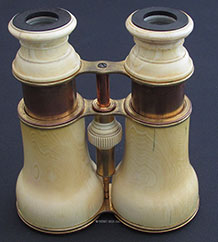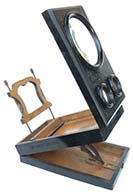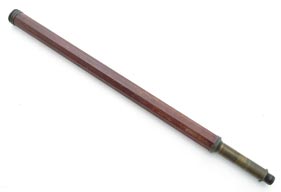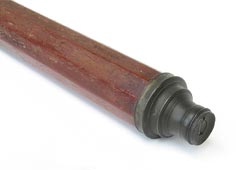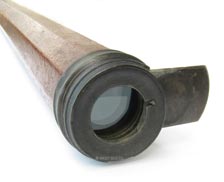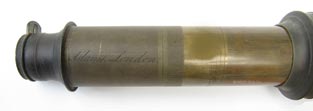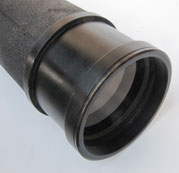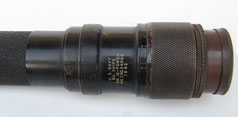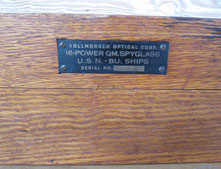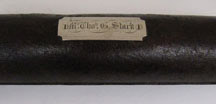TELESCOPES & OPTICS
Catalog Page 21
When no price is shown, use
Click on photos for larger images.
Click
![]() for ordering details.
for ordering details.
|
21.92 AMERICAN TRIPOD TELESCOPE.
Scarce, late 19th century American
floor standing tripod telescope engraved "HARVEY & LEWIS
CO., U.S.A." on the end of the main tube. This premium
quality optical instrument features a long solid brass main
tube with its original state-of-the-art achromatic objective
lens measuring 3inches in diameter. Fine adjustment is
accomplished by means of the precision rack and pinion
focusing device with smooth action, operated by a large
knurled brass knob on the right side of the telescope
body. Period internal optics combine to form a clear,
upright image of extreme magnification with good clarity and
no distortion. Such early telescopes were not marked with
their "Power times X" as in modern optical
devices. However this telescope is extremely
powerful and surely must be 20X or more! It is mounted
to its *ORIGINAL*oak tripod with heavy, solid brass support
pedestal which provides train and elevation, making for easy
viewing and a most handsome display. The main telescope
barrel measures 38 inches in length and is 49 inches long
overall. As configured the entire assembly is 6 feet
tall. Pristine cosmetic condition in all respects with
no flaws in the optics whatsoever. A magnificent furniture
grade American instrument of the
highest optical quality which would make an impressive
statement in the library, den, or living room with a
view! |
|
PERSPECTIVE
|
DETAIL
|
STRUT
|
OBJECTIVE
|
|
SIGNATURE
|
USA
|
|
21.29 18th CENTURY
MONOCULAR. High quality gentleman’s
monocular pocket spyglass, otherwise known as an “object
glass.” This rare example is by the noted makers
“Gilbert & Gilkerson / Tower Hill, London”
as hand-engraved on the single silvered draw.
The original two lens system with early singlet
objective produces a surprisingly clear, magnified, upright
image. This mini-telescope is made of sterling silver
and silver plated brass. The main barrel is finished
in a thick nondescript mustard yellow covering with an
obviously enduring nature. It measures just over 3
inches closed and 4 inches long fully extended.
Typical of these early glasses, there is no stop on the
draw, so it will pull out completely. The objective
lens is nearly 1 ½ inches in diameter. This
little glass is in excellent overall condition. There
are a number of micro nicks and scratches on the main barrel
covering which only add to its texture and looks.
There are no dents or cracks and the lenses are
perfect. A very high grade
optical instrument from famous makers over 200 years
old!
|
|
CLOSED
|
OCULAR
|
OBJECTIVE
|
MAKERS
|
 |
|
REVERSE
|
OBSERVERS
VIEW |
OBJECTIVE
|
|
TRIPOD
|
MAKER
|
|
21.09 HUGE REFLECTOR TELESCOPE.
Certainly one of the largest antique telescopes of
its type available on the market today. This 19th
century English reflecting telescope is of heavy all brass
construction. It features two thick parabolic mirrors
made of highly polished “speculum” metal which
combine to produce a clear, large field image, unobtainable
with a refracting telescope of the same size. The
forward focusing mirror is set on an internal track
connected to a screw gear operated by a small brass hand
crank on the viewing end. Turning the crank allows the
observer to make fine focusing adjustments. For side
to side movement and raising and lowering (train and
elevation) the telescope is equipped with a heavy brass
strut attached by wing nuts to a circular brass support
mounted on the center post. It is connected to
another drive shaft which is operated by a large brass
wheel with handle. When the wheel is turned it
gradually raises or lowers the entire telescope body with a
smooth action. This massive telescope measures 68
inches high as shown. The barrel is 36 inches long and
8 inches in diameter. The lovely hardwood tripod
stands 53 inches tall to the top of the turret head.
It supports the revolving brass yoke with trunnions on which
the barrel is mounted. The yoke measures 11 inches
wide. The spread between the tripod legs is
approximately 45 inches x 3. Complete with its
original removable eyepiece and large objective lens
cap. All components are of solid brass in their bright
lacquered finish. |
|
OCCULAR
|
DETAIL
|
OBJECTIVE
|
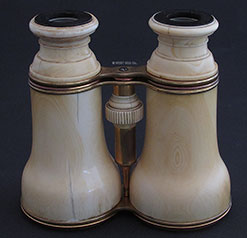 |
|
21.88 TELESCOPE. Impressive early 19th century all brass sea captain’s 5-draw spyglass which telescopes from only 13 1/2 inches closed to an amazing 52 ½ inches fully extended! This unusually large telescope is likely of English manufacture, and judging by the early style “nipple” eyepiece, dates from the 1830’s. The big achromatic objective lens is made of classic old green crown and flint glass measuring 2 ½ inches in diameter. In conjunction with the internal erecting system it produces a highly magnified upright image of surprising clarity. This hefty hand-held telescope weighs 5 pounds and is complete with its original objective lens cap and ocular dust slide of early form Beautiful, fully restored cosmetic condition with bright brass surfaces. All 5 optical elements are original and in perfect condition. They don’t come any nicer or much bigger! 1295 |
|
PERSPECTIVE
|
EXTENDED
|
DRAW
|
OBJECTIVE
|
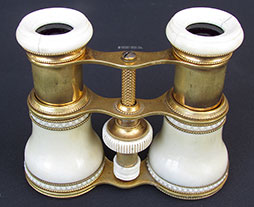 |
|
21.87 O.O.D. SPYGLASS. Very scarce, beautifully preserved pre-World War II vintage U.S. Navy telescope signed “US. NAVY BU. SHIPS O.O.D. 10-POWER N.G.F. (Naval Gun Factory) TYPE NO. 2379, 1940.” This highest quality optical device is of solid brass with a leather covering on the barrel. All optics are original and produce an exceptional, highly magnified image of amazing clarity. This hand-held telescope is equipped with a built-in focusing system with knurled ring which turns with a good tight action to produce the clearest image imaginable! This officer’s telescope is housed in the upper half of its original machine dove-tailed oak box which importantly bears the original brass maker’s plate reading, “KOLLMORGEN OPTICAL CORPORATION 10 – POWER – OFFICER – OF – THE –DECK SPYGLASS MK. II U.S.N. - BU. SHIPS SER. NO 2379.” The telescope itself is 23 inches long and 2 ¼ inches wide at the widest. The box measures 25 inches long by 3 ¾ inches wide and is 2 inches deep. Outstanding original and functional condition is all respects noting the absence of the lower half of the box. This telescope represents the best example of state-of-the art optics for its time, made even more desirable by the fact that it is a scarce pre-war example. No doubt it cost *MUCH* more in 1940 Dollars than we are offering it for now! 595 |
|
OCULAR
|
OBJECTIVE
|
IDENTIFICATION
|
|
IN BOX
|
BOX LABEL
|
|
|
|
21.76 EARLY SEA CAPTAIN’s LONG GLASS. Especially nice hand-held telescope made by the famous optician and mathematical instrument maker Thomas Harris, as beautifully engraved in script near the eyepiece, “T. Harris, London Night & Day.” This fine, olde English example has an early form single draw with wooden barrel and brass fittings. The ocular end “nipple” is indicative of telescopes circa 1800, retaining its spring-loaded sliding dust cover. The large wooden barrel is turned of a single piece of solid mahogany which is in its original black finish. The objective end houses the old greenish glass achromatic lens which is protected by its press-fit cap with built-in sliding dust cover! The all original optics produce a highly magnified, upright image of surprising clarity. This genuine Captain’s spyglass measures 20 ¾ inches closed, 35 ¼ inches long fully extended and is 2 ½ inches in diameter. It is in a very nice state of original preservation. There are the expected age checks in the solid wooden barrel. Such cracks are present in all wooden articles over 200 years old. But this venerable example evidences great respect and careful use lavished upon it for over 2 centuries! 895 According to Gloria Clifton, author of “British Scientific Instrument Makers 1550-1851”, 1995 Philip Wilson Publishers Ltd., London, Thomas Harris (I) worked as an optician, mathematical and philosophical instrument maker and a globe maker from 1790 to 1826. In 1804 he was recorded as working at 140 Fleet Street, London. Thereafter, an address of 52 Great Russell Street, Bloomsbury, London is cited. |
|
|
 |
 |
 |
|
|
|
|
|
|
21.79 STEREO VIEWER. Extra fancy Victorian era stereo viewer and magnifier. This beautiful, high quality optical instrument is as decorative as it is functional. It consists of three-tiers of ebonized hardwood profusely engraved with floral decorations embellish in gold. On the top front is a large monocular lens for viewing photographs in detail. Below it a pair of oculars are for viewing stereo cards. A height-adjustable pierced wooden support mounted on two brass rods is provided for holding a card or photo. It is also adjustable for depth, sliding back and forward in grooves on each side. The front of this viewer is hinged with a brass “stay” on the right to lock it in the upright viewing position. When not in use it folds closed on a friction latch. The bottom tier is equipped with a wooden track and folding arm which allows the viewer to be inclined to one of three preset angles. The front bears the oval brass maker’s plaque reading “76 .UNIS . FRANCE 3 STEREOSCOPES - PARIS” 10 ½ inches long by 6 ¾ inches wide and 3 inches thick when closed, elevating to a working height of 16 ¾ inches. Superb original condition. 1295 This offering comes complete with several stereo viewing cards with extremely interesting subject matter. |
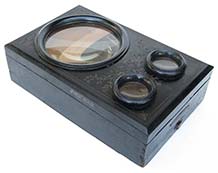 |
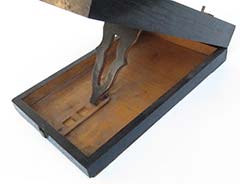 |
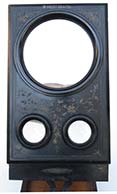 |
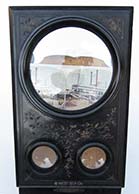 |
|
|
|
|
|
|
21. 86 EARLY TELESCOPE by IMPORTANT
MAKER. Especially rare, 10-sided, reverse
tapered spyglass made by the famous London optician and
nautical instrument maker George Adams. This wonderful
surviving example of a decahedral telescope is signed on the
single draw in elegant cursive script “Adams,
London.” Evidencing its early origins
this spyglass has an unusual 5 element erecting system in
the single draw vs. the usual 4. The lenses are held
in by threaded retainers instead of being “rolled in,”
as exemplified in later telescopes. Together with the
singlet, non-achromatic objective lens 1 1/8 inches in
diameter, the system provides a sharp, highly magnified
image with the typical peripheral chromatic aberration
characteristic of pre-1750 telescopes. The barrel is
constructed of one solid piece of mahogany, hollowed out in
the traditional decahedral form. The draw, with
early-form “nipple” has no stop, meaning it will
pull free from the main barrel. Again this is a
characteristic indicative of only the earliest hand held
telescopes. Both of the spring-loaded objective and
ocular dust slides are in place and operate properly.
The overall condition of this telescope can only be
described as nothing short of amazing original
condition in consideration of its seaborne
life spanning more than 260 years! The barrel is in
its original finish with expected minor scuffs and mars from
actual use. All of the brass components have acquired
a rich, deep age patina. All 6 of the original glass
lenses are in perfect
condition. 31 inches long overall. The main
barrel measures 24 ½ inches long and is 1 ¾ inches
thick at the widest. Another of our museum quality
offerings representing a real prize for the finest
collection.
2600 Peter Dollond (1731-1821,) son of inventor John Dollond, was widely credited with producing an effective achromatic lens, for which he was granted a Royal patent in 1758. Up to that time limitations in glass making and lens grinding had made it necessary to manufacture small, thin lenses with long focal lengths in order to obtain maximum magnification. Accordingly, early high-powered refracting telescopes such as this example, required unusually long barrels in relationship to the diameter of their objective lens. |
|
21.85 U.S. NAVY QUARTERMASTER’s
SPYGLASS. Authentic World War II era
spyglass of the type used by bridge personnel underway and
the officer to the deck in port. This high quality
optical device is marked “U.S. NAVY BU. SHIPS QM.
16-POWER MK.1 NO. 24068 / 1942” on the eyepiece
end. The eyepiece is knurled to enable focusing from
-6 to plus 6 diopters, which it does very smoothly.
The long tapered barrel is of brass covered in a faux
leather material. The large clear objective lens is
housed in it blackened brass retainer in perfect
condition. It provides an upright image of high
magnification with some small specks noticeable in the
field. This spyglass measures 31 inches long by 3
inches wide on the objective end. It is complete in it
original felt-lined dove-tailed oak box with brass hinges
and closures. The inlaid brass maker’s label
reads “Kollmorgen Optical Corp. 16-POWER QM. SPYGLASS
U.S.N. BU. SHIPS Serial No. 24068.” The box measures
32 ¼ inches long, 4 ¾ inches wide and 4 ¾
inches high. Overall cosmetic condition is “excellent.”
“QM” stands for Quarter Master, those sailors whose rate comprised shipboard activities such as navigation, lookouts, timekeeping and underway operations. |
|
21.78 SIGNED & IDENTIFIED
TELESCOPE. Excellent mid 19th century English
3-draw gentleman’s telescope by the renowned makers “Negretti
& Zambra, London” as signed on the draw.
This quality optical instrument features an achromatic
objective lens 1 1/2 inches in diameter which produces a
clear upright image of great magnification and
clarity. A beautifully hand-engraved sterling silver
plaque on the main barrel reads “Mr. Thos. G. Stark”
in Gothic lettering. The eyepiece is complete with its
built-in pivoting dust cover. This telescope measures
22 ¾ inches extended and 8 inches closed.
Excellent original condition in all respects.
Ex. Collection of a well-known Maritime Museum, the identity of which will be provided to the purchaser along with a written statement documenting the fact. |
|
CLOSED
|
OWNER
|
SIGNATURE
|
|
21.77 EARLY 8-SIDED TELESCOPE. Mid-18th century or earlier faceted barrel English telescope commonly referred to as a "decahedral." This particularly fine example of an early mariner’s telescope features a solid body of “flame grained” mahogany with brass fittings. The early form singlet objective is a thin, narrow piece of flint glass contained within a threaded brass receptacle. It is protected by its early form spring-loaded sliding dust cover. Evidencing its early origins, this telescope has only 3 lenses in its erecting system vs. the more common 4 which were standard by the 19th century. In addition, each of the lenses are individually held within there receptacles – a feature indicative of olde English manufacture dating back to the late 1600’s. The eyepiece is of the nipple type also with its original sliding dust cover. This lovely telescope produces a clear, state-of-the-art, highly magnified image for its time, noting it is of the pre-achromatic type. There is a small peripheral crack in the objective lens which does not affect the image. Otherwise condition must be rated as “outstanding.” The barrel itself is in amazing condition with the original finish showing just the right amount of old wear that collectors seek. The brasses are equally fine. 13 ¾ inches closed and 23 ¾ inches fully extended. A rare telescope! 949 Ex. Collection of the Kennebunk Maritime Museum, Kennebunkport, Maine. Peter Dollond was awarded a patent for his non-achromatic lens amidst a flurry of controversy in 1758. Earlier telescopes provided an image slightly distorted by color on the periphery of the field. This telescope is an example of that old type. |
|
21.74 U.S. NAVY GUNSIGHT TELESCOPE. WWII ship’s telescope used on a U.S. Navy combatant. This solid cast bronze optical instrument is marked on the side, “TELESCOPE MK 78 U.S.N. NO. 2889 INSP. HTM 1943 MINNEAPOLIS HONEYWELL REGULATOR CO.” It is of the prismatic type having a 1 /34 inch objective lens with built-in cross hairs. The all original optics are set for infinity (beyond 30 yards) and produce a highly magnified image of amazing clarity. Above the eyepiece are two knobs. The one on the left is marked “DENSITY KNOB,” presumably for aperture. The knob to the right is marked “RAY FILTER KNOB.” It rotates an inner disc containing 4 filters. They are marked on the body of the telescope, “RED, YELLOW, CLEAR, and POLARIZING” with a small pointer on the knob indicating the respective function. The body of the telescope is additionally marked “MH” in two places and “AIR OUTLET” above a set screw on the right side. The left side is equipped with a mounting plate and a window for a small electric light which has been removed. The base of this instrument consists of a rectangular mounting plate 2 ½ by 4 ½ inches with four mounting holes. The entire instrument measures 6 inches long, 5 inches high by 4 ½ inches wide and weighs 8 pounds. It is in a lovely state of original preservation. The bronze surfaces are bright and free from corrosion. The optics are clear and crisp. A most unusual relic from a World War II capital ship. 395 |
|
OBJECTIVE
|
OCULAR
|
REVERSE
|
VIEW 100 YDS
|
 |
|
21.73 TRIPOD TELESCOPE by the MASTER.
Genuine, late 18th century English floor standing
telescope made by Dollond of London as signed in pencil
around the main lens. This most impressive instrument
consists of a long tapered wooden barrel hewn from a
single piece of mahogany! The perfect doublet
objective lens is housed within a brass collar on the large
end, while the viewing end is equipped with a fine rack and
pinion focusing device operated by a large knurled
knob. The erecting tube with eyepiece inserts with a
sliding fit into the brass collar. As configured the all
original optics provide a clear, upright image which is
highly magnified with no chromatic distortion -- Dollond’s
trademark. The objective retains its original
press-on dust cap while the eyepiece has the typical
built-in pivoting dust slide. This telescope is
supported by its original brass collar with two knurled
thumbscrews. The hinged, leather-lined collar holds
the telescope securely while affording the option of removal
for separate storage or hand-held use. The collar is
set atop its heavy solid brass yoke which allows for smooth
train and elevation while providing a steady viewing
platform. The handsome tripod has solid mahogany legs
which are each height-adjustable. The overall length of this
telescope is 60 inches when focused at infinity. The
objective lens is 2 3/4 inches across. The main barrel
itself measures 51 1/2 inches long with a diameter of 3 1/4
inches. As shown, the entire presentation stands
approximately 79 inches tall, accommodating any height of
eye. Peter Dollond (1731-1821,) son of inventor John Dollond, was widely credited with producing an effective achromatic lens, for which he was granted a Royal patent in 1758 and enjoyed the patronage of the Crown. For years the patent afforded Dollond access to the finest optical materials. Despite that fact, limitations in state-of-the-art lens grinding in the 18th century still made it necessary to manufacture lenses with long focal lengths in order to obtain maximum magnification. Accordingly, early high-powered refracting telescopes such as this example, required unusually long barrels. (Gloria Clifton, “Directory of British Scientific Instrument Makers 1550-1851,” 1995, National Maritime Museum, London.) |
 |
 |
 |
|
|
|
|
 |
 |
|
|
|
 |
|
21.72 EARLY TRIPOD TELESCOPE.
Fabulous, late 18th century English library
telescope made by “D: JONES, CHARING, CROSS, LONDON.”
as engraved on the end of the barrel. This handsome
all brass refracting telescope has a tapered main barrel
affixed to a complex equatorial mount set atop graceful
Queen Anne style cabriole tripod legs. By means of
rotating tabs, the gearing on the mount allows the viewer to
make minute adjustments in both train and elevation of the
telescope, most useful during celestial observations.
Further, the mount allows the viewer to make large vertical
and horizontal adjustments and provides a knob to “lock
in” the desired direction once it is obtained.
With its achromatic doublet objective lens and all original
internal erecting system this telescope produces a crisp,
clear upright image of high magnification with no chromatic
distortion. Focusing is accomplished by a smooth rack
and pinion system operated by a large knurled brass
knob. To these ends the telescope is equipped with
both interchangeable terrestrial and astronomical eye
pieces. The terrestrial eyepiece has a built-in sun
filter which cleverly doubles as a pivoting dust
cover. The celestial eyepiece is also equipped with a
dust cover. This state-of-the-art scientific
instrument has an overall length of 38 ½ inches,
standing 23 inches tall as shown and measuring 12 ½
inches wide at the base of the tripod. The main barrel
is 27 ½ inches long with a maximum diameter of 2 5/8
inches and the objective lens measures 2 1/8 inches in
diameter. The entire presentation stores snugly in its
original fitted mahogany box with hinged lid, 2
hook and eye closures and original functional box lock with
skeleton key! It is in an absolutely remarkable state
of original preservation with virtually no cracks, chips or
losses. This condition for such a carrying case of
this age is virtually unheard of! The telescope itself
is in fine cosmetic condition, noting some minor distress in
the bottom of the main barrel, noted here only for
thoroughness of description. A lovely, fully
functional high grade optical device 220 years old!
In 1766 David Jones (I) was apprenticed to the famous master optical instrument maker and inventor, Benjamin Martin (w. 1738-1777). Thereafter Jones was listed as a mathematical instrument maker and optician, first at 25 Charing Cross, London, then 35 Charing Cross from 1785 to 1793. (Gloria Clifton, “British Scientific Instrument Makers 1555-1851, The National Maritime Museum, Greenwich, 1995.) |
 |
 |
|
|
|
|
MOUNT |
 |
||
|
|
BOX |
SIGNATURE |
 |
 |
 |
 |
 |
 |
 |
 |
 |
 |
 |
 |
 |
 |
 |
 |
 |
 |
 |
 |
 |
 |
 |
 |
 |
 |
© 1998-2014 West Sea Co. All rights reserved.






















